|
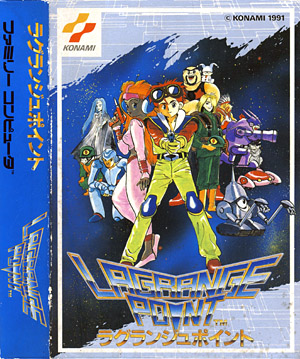
|

|
|
ラグランジュポイント
©Konami 1991
Release: 1991-04-26 (¥8500)
Cartridge RC851
Role Playing Game
|
Lagrange Point is a science fiction role playing game developed and
published by Konami. In the 22nd century, humanity has begun to explore
and colonize the worlds of other stars. Three outer-space space stations were
built by the ISIS corporation at the Lagrange point between the
Earth and the Sun - Satellite Base, Land 1 and
Land 2. One day, after coming under attack by strange and mysterious
mutant-like creatures, the Lands turn into hostile wastelands. Earth
decides to send several expeditions to investigate the situation, but none
returned. Lagrange Point stars Jin, a member of the third
expedition on a mission to discover the truth behind the attack. But, as
they reach their destination, he and his team are stalked by heavily armed
robots and only Jin survives the attack. Lagrange Point
follows a traditional RPG formula laid out by similar games at the time,
such as top-down exploration, round based battles, stores, experience points
and so forth. However, Konami added new concepts and valuable ideas
to the mix. Although the player can control up to four characters at the
same time, a total of ten different heroes can be played throughout the
game, from humans to cyborgs and robots. Additionally,
Battery Points (BP) replace the traditional magic points and are
used to fuel attacks - however, although Health Points (HP) do
increase after each level-up, Battery Points don't and B Tanks
must be purchased throughout the game in order to do so. The player also
doesn't automatically gain money after each battle and must instead visit
Terminal Rooms to collect his loot - thankfully, these rooms can be
found at every corner of the game's numerous cities and are also used to save
the game in progress or heal the party. Lagrange Point's content is
vast and expansive, and special vehicles give the player ample chance to
roam the world in various degrees of style, from the Solar Car, the
all-terrain Mobile to the Cruiser boat or the flying
Hoverplane. As the game progresses, many more features are made
available, such as the ability to combine and create new weapons in
Factories or the option to leave characters behind for later use
(both only available in the Satellite base).
|
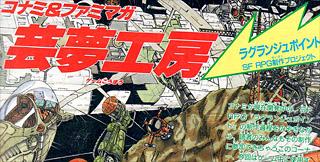 Lagrange Point is especially interesting for a fairly unusual reason.
In the fall of 1990 and to commemorate the 100th issue of the Japanese
Family Computer Magazine (also known as "Famimaga"),
Konami apparently offered the readers the opportunity to send
their opinion and ideas, and to contribute to the design of Lagrange Point.
The project, called 芸夢工房 ("Geiyume Kōbō", The "Geiyume Studio")
allowed players to design some of the enemies, various character dialogs and
texts, parts of the soundtrack and even the final name of the game and the
title's logo. After the game was released, Family Computer Magazine
praised its numerous qualities and a four-episode comic even appeared
Lagrange Point is especially interesting for a fairly unusual reason.
In the fall of 1990 and to commemorate the 100th issue of the Japanese
Family Computer Magazine (also known as "Famimaga"),
Konami apparently offered the readers the opportunity to send
their opinion and ideas, and to contribute to the design of Lagrange Point.
The project, called 芸夢工房 ("Geiyume Kōbō", The "Geiyume Studio")
allowed players to design some of the enemies, various character dialogs and
texts, parts of the soundtrack and even the final name of the game and the
title's logo. After the game was released, Family Computer Magazine
praised its numerous qualities and a four-episode comic even appeared
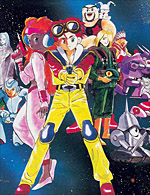 within its pages (it was curiously never published as a stand-alone comic
and only the first half was included in the offical guidebook).
within its pages (it was curiously never published as a stand-alone comic
and only the first half was included in the offical guidebook).
Apparently, Lagrange Point wasn't a huge success - the 'late' release of the
game (the Super Famicom system was already available in Japan in 1991) and
the high production cost of the cartridge may have contributed to the low sales
number. It was however later referenced in other Konami games, such
as Motocross Maniacs Advance (Game Boy Advance, 2002) where a race track
is named 'Lagrange Point', and two rearranged tracks can be
found on the Kukeiha Club & Konami Kukeiha Club Best Vol.1
CD soundtrack originally released in 1997.
|
|
Lagrange Point uses an onboard FM synthesis soundchip called the
VRC 7 and it was apparently the only Famicom game produced by
Konami to take advantage of the chip (Tiny Toon Adventures 2
included a VRC 7 chip, however, and for unknown reasons, the game didn't take advantage
of its superior sound capability).
The six extra sound channels of the VRC 7 give
Lagrange Point's soundtrack an unique depth and definitively a 16-bit bit feel not
found in any other games released for Nintendo's 8-bit system.
Interestingly, the VRC 7 was apparently a cut down version of the
Yamaha YM2413 (which featured 9 channels). The YM2413 was an low-cost FM
synthesis sound chip already available in Japan for the
Sega SG-1000 Mark III (aka Master System) and the
MSX computers (MSX2, MSX2+, MSX Turbo-R
and FM-PAC/MSX-MUSIC extensions).
|
Game Staff (Copied from the end credits) :
|
Game Design
Med Okawa
Sanchan
Charlie Mata
Yutaka Kaminaga
Daisuke Fujii
Scenario Concept
Yuuichiro Enoki
Scenario
Ryosuke Saejima
Ryouchi Sato
Program
Takomonaka Higuchi
Hanaten Yamamura
Gomenne Horio
|
|
Character Design
Fujihiko Hosono
Graphic Design
Purple Oda
Elf Tateishi
Keroyon Teisaku
Madonna Taira
Music
Akio Dobashi-Rebecca-
Noriyuki Takahashi-Rebecca-
Tum's Boogie
and
The Resurrection Of Sabbath
-Ending Theme-
Ku-Kei-Ha Club
|
|
Sound Design
Sukenomiya Fujito
Nazonazo Suzuki
Kurokotai
Yamada S.
Special Thanks to
Family Computer Magazine
and
Game Kōbō Readers
Presented by
Konami
We do not realize
What we have on Earth
Until we leave it...
Jim Ravell
Thank You
|
|
G
O
O
D
I
E
S
|
|
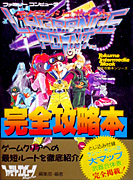
Japanese Guidebook
|
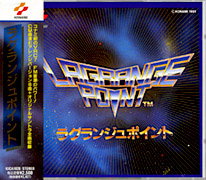
Japanese Soundtrack
|
|
|
O
M
A
K
E
|
|
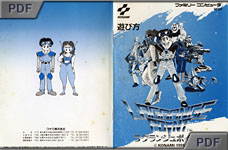

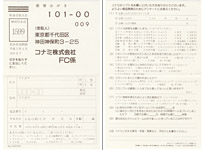
|
|
|
Click on picture to enlarge |
S
E
C
R
E
T
S
|
|
Lagrange Point was never released outside of
Japan, and although a fan translation has been in the making
since 2007, there is no English patch for the game
available at the moment. Here are some information to help you
navigate around some of the menus.
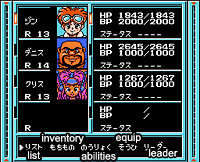 Menu screen:
Menu screen:
Press START to open the menu screen.
リスト (List) - lists information about characters and items, or look
at the maps (the 'list'
screen comes with four options - Battle Character, Item,
Side Character and Kit).
もちもの (Inventory) - use items.
のうりょ (Abilities) - use characters' special abilities.
そうび (Equip) - Equip weapons and armors.
リーダー (Leader) - change the party's leader.
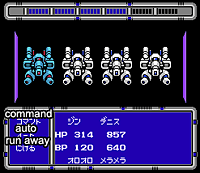 Battle screen:
Battle screen:
Up to six enemies can attack at once (multiple waves can appear later
in the game).
The bar at the top of the screen represents the
enemys' health.
The Battle Screen has three main options:
コマンド (Command) - manual battle. There the player
decides what action ('command') to take against the enemy,
and this one character at the time.
This option comes with four options - Fight,
Special Attacks (called 'Kimewazas'), Special Abilities and
Items.
オート (Auto) - Automatic battle. Unlike other games at the
time, this option in Lagrange Point is particularly
effective!
にげる (Run Away) - gives the player a chance to escape.
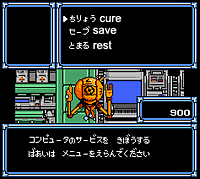 Terminal Rooms/Computer Services:
Terminal Rooms/Computer Services:
Terminals are the most important places in the game, and are
usually located around each town or at key points. More than
giving the player money after in-game battles, they also
act as check points and this is where the party
is revived after dying.
Terminals offer three options:
ちりょう (cure) - cures any status ailment.
セーブ (save) - saves the game in progress.
とまる (rest) - regain all health and BP points.
|
|
|
|
LK

|
|
Add your Pov here !
|
P
O
V
s
|
|
Lagrange Point is easily one of the most advanced Role Playing
game available for the Famicom system. Although the progression
is fairly linear, the game features a rather complex interconnected world
that requires a lot of exploration and rehearse. Additionally, thanks to
surprisingly (for Famicom standards) large and colorful sprites
on screen, the visuals haven't aged as badly as other games from that
time frame - actually, this RPG often looks closer to a 16-bit game than
an 8-bit game! This also extends to the soundtrack which, thanks to the
onboard FM synthesis audio chip, sounds terrific. Leveling-up and random
battles will still cause some teeth grinding though - difficulty
often spikes, forcing you to turn aside and bash monsters to level-up.
Thankfully, a rather clever 'auto' battle mode is available and
makes the whole process much more bearable (and it speeds up fights too!).
Finally, although the game only uses Japanese Hiragana and
Katagana, Lagrange Point is nearly impossible to play if
you don't speak the language... and no English translation is currently
available (although great guides are). All in all, Lagrange Point
is a polished and immersive sci-fi RPG that always keeps expanding in
the most surprising ways. A great game.
|
|
|
|